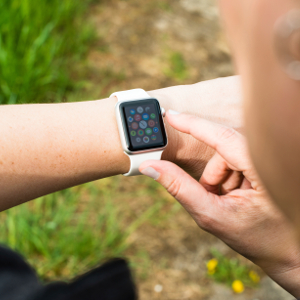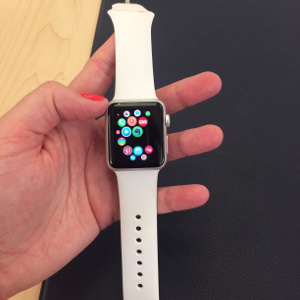The Apple Watch will Revolutionize (Wearable) Marketing

Just when you thought your business was caught up with mobile trends, there is something new that may need your immediate attention: wearables. Wearables, like Google Glass, Fitbit trackers and the newest Apple Watch yield important implications for the changes in marketing strategies that will be needed in the very near future.
After much anticipation and excitement, Apple released its newest product the Apple Watch on April 25th. An estimated 957,000 watches have already been sold, which is more than its Android competitor, Samsung, sold all last year. It is predicted that this is just the beginning of wearable technology and techies are predicting wearables to become a huge success by 2020.
I personally have ordered the watch, and I am anxiously awaiting its arrival. Like many others, I went to an Apple store to try on and interact with the watch before I bought it. I am very loyal to the Apple brand, and I thought this new technology would fit in seamlessly with my devices and apps I already use. I have read mixed reviews about the watch, but after briefly trying it on and testing it out I am very eager to get mine. The most unique feature, in my opinion, is the gentle tap the watch gives you when new notifications come in. I couldn’t help but think how it would affect our lives. I think the watch will create a need to reevaluate content and marketing strategies in three key areas.
 Personalization
Personalization
Apple stated in its guided tour video that, “The new Apple Watch is the most personal device yet, because it’s the first one you actually wear.” What is more personalized than a device that allows you to share your heart beat, tracks your heart rate and gently taps your wrist with information? This gives marketers and content strategists the opportunity to further personalize their content. Wearables will lend even more information to businesses about browsing and buying behaviors. With recent SEO updates from Google and other key players in the mobile arena, it will be interesting to see what changes wearable technology will bring to enhance the user’s experience.
Location-based information
The Apple Watch is easy to use when you’re on the move. Whether you are running, driving or sitting at a desk, wearables will be able to track your location very easily. With geotracking and geofencing, it will be possible for wearables to remember the places you frequent and your current location. This can allow marketers to send instant notifications of specials, coupons or current deals. Location information can also be used to send important updates about the weather, traffic congestion or news alerts.
Even more glanceable
Our phones have become an extension of our hands to do anything we need it to do. We can expect wearables to do the same and even more; it will no longer be an extension of our hand but part of it! Developers and content strategists will need to tailor content for even smaller screens. Essentially the same messages we want to get out will need to be done so in very tiny, precise ways. There will be no room for clutter or fluff. Photos and short messages will need to be used to keep attention.
As mobile changed the way we strategized and marketed, so will wearables. I think there is still plenty of time to develop plans and start budgeting, but it is definitely something to keep in mind for the future. It seems that we consistently need to deliver smaller and smaller bits of information, but in larger quantities. Becoming very succinct, innovative, interesting, yet creative, will be one of the challenges in wearable marketing.
If you enjoyed this post by Elizabeth, check out some of her other blogs!
Elizabeth Muckensturm—Communications and Media Professor

 Personalization
Personalization

